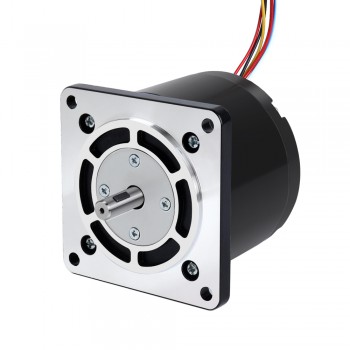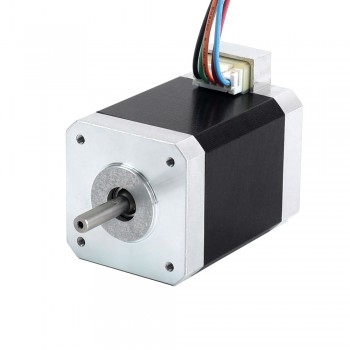1.Definition of five-phase stepper motors
A five-phase stepper motor is a motor powered by a five-phase AC power supply. Its structure is more complex than that of a four-phase stepper motor, and it can provide higher control accuracy and finer step lengths. This type of motor is usually used in application scenarios that require high-precision control, such as precision CNC machine tools, high-precision robots and other equipment. The working principle of a five-phase stepper motor is to control the power-on sequence of the five windings and the magnitude of the current to make the rotor produce different rotation angles, thereby achieving precise position control. Due to the high precision of the five-phase stepper motor, it has been widely used in high-precision automation equipment.
2.How to control the direction of the five-phase stepper motor
1.Change the direction of the current
The direction of the five-phase stepper motor can be achieved by changing the direction of the current. Usually, a five-phase stepper motor has two sets of coils, each with two pins, marked as A+, A- and B+, B-. If you want the motor to rotate clockwise, the current should enter the coil from A+ and B- and exit the coil from A- and B+; if you want the motor to rotate counterclockwise, the current should enter the coil from A- and B+ and exit the coil from A+ and B-.
2.Change the step sequence
Stepper motor control is actually controlling the step sequence of the motor. The step sequence of a five-phase stepper motor is AB-BC-CD-DE-EA. If you need to change the direction of the motor to the opposite direction, you need to change the step sequence. The method is to reverse the flow of current, that is, first energize the E and D coils, then energize the A and E coils, and so on.
3.Use a direction controller
If you don’t want to change the connection method or step sequence in the circuit, you can also use a direction controller to change the direction of the five-phase stepper motor. The direction controller can add a reversing switch at the input or output of the motor control signal. When you need to change the direction, just switch the switch.
3.Advantages of five-phase stepper motors
1.Smooth motion and high resolution: The five-phase stepper motor makes the rotation of the stepper motor smoother by introducing more phases, reduces vibration and noise, and improves the stability of the mechanical system. It can achieve a smaller step angle and improve the resolution of the stepper motor through microstepping, which is very useful for applications that require precise positioning and control.
2.Low speed and high torque: The five-phase stepper motor can provide higher output torque at low speed, which is very beneficial for some applications that require low speed and high torque output, such as medical equipment and precision instruments.
3.Reduce resonance and high-speed performance: At certain frequencies, stepper motors may resonate, resulting in unstable motion. Five-phase stepper motors can effectively reduce resonance and improve the smoothness of the system’s motion. At the same time, it can better control the motor at high speed and reduce the possibility of losing steps, which is very important for applications that require high-speed motion, such as printing presses and CNC machine tools.
4.High efficiency: By better controlling the phase of the motor, the five-phase stepper motor can achieve the same output power at a lower current, thereby improving the energy efficiency of the system.
5.Strong adaptability: The five-phase stepper motor driver is suitable for various stepper motors, including different types of motors such as bipolar, quadrupole and octapole, and has a wide range of applicability.

4.Application fields of five-phase stepper motors
1.Automation equipment and instruments: The five-phase hybrid stepper motor is suitable for various small automation equipment and instruments, such as pneumatic marking machines, labeling machines, cutting machines, laser marking machines, plotters, engraving machines, CNC machine tools and pick-and-place devices. In these applications, the five-phase stepper motor can provide low vibration, low noise, high precision and high speed performance to meet user needs. 2.Precision CNC machine tools and high-precision robots: Due to its high-precision characteristics, the five-phase stepper motor is widely used in high-precision automation equipment such as precision CNC machine tools and high-precision robots. These devices have high requirements for precision and performance. Five-phase stepper motors can provide finer steps and higher control accuracy to ensure accurate operation of the equipment.
3.Industrial automation, machine tools, printing presses: Five-phase stepper drives are mainly used in industrial automation, machine tools, printing presses and other fields, with precise angle and speed control as the main features. These application areas require stepper motors to provide stable and reliable operation and precise position control.
4.Textile machinery and equipment: Stepper motors are widely used in textile machinery and equipment, such as computer embroidery machines. In particular, five-phase hybrid stepper motors use high-phase stepper motors to reduce step angles and improve control accuracy. They are suitable for applications with smooth operation, low noise, fast response and long service life.
5.Conclusion
As a special stepper motor, the five-phase stepper motor has the advantages of high precision, high efficiency and low noise. Its working principle, circuit structure and control method are different from those of traditional stepper motors, but its application range is wider. In the future, with the continuous advancement of science and technology and people’s increasing demand for high-precision intelligent equipment, five-phase stepper motors are expected to be used in more fields.
Source:https://www.steppernews.com/2024/08/application-fields-and-advantages-of.html
